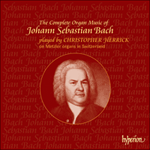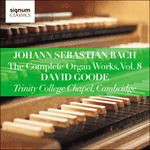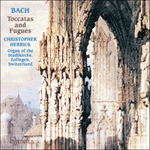
Welcome to Hyperion Records, an independent British classical label devoted to presenting high-quality recordings of music of all styles and from all periods from the twelfth century to the twenty-first.
Hyperion offers both CDs, and downloads in a number of formats. The site is also available in several languages.
Please use the dropdown buttons to set your preferred options, or use the checkbox to accept the defaults.
The nickname given for the pair—‘Dorian’—highlights their modal quality, and stems from the absence of a key signature in both Toccata and Fugue. Yet the opening of the Fugue, with its prominent B flat, highlights that strictly these works are written not in the Dorian mode but in the Aeolian mode, which has been transposed from A to D. Yet the flattened seventh of the mode projects the chief affect of the Fugue as sombre and serious. This is reflected in the writing of the subject: long, soaring, taking its time over an initial ascent of an octave, before a slow return. Thus the subject strikingly highlights the ‘D’, the tonic note, further highlighting the Fugue’s modal centre. Another feature of the subject is its rhythmic syncopations, the notes skipping off the main beat, producing some beautiful episodes later, with Bach making full use of the possibilities of suspensions. The final pedal entry of the fugal subject, a few bars before the end, is one of Bach’s most glorious.
from notes by George Parsons © 2018
 Bach: The Complete Organ Works Bach: The Complete Organ Works‘Let me say without hesitation that Herrick’s performances are models of clarity, accuracy, precision and musicality … this is a complete Bach th ... ‘Herrick is one of the few organists who does justice to these difficult, elusive pieces … What a singular joy to hear the organ played with such ...» More |
 Bach: The Complete Organ Works, Vol. 8 Bach: The Complete Organ Works, Vol. 8This eighth volume in David Goode's intégrale of Bach's organ works is gloriously framed by the imposing pairings of the 'Dorian' Toccata & Fugue and the 'Wedge' Prelude & Fugue.» More |
 Bach: Toccatas and Fugues Bach: Toccatas and Fugues‘Stupendous organ sound … one of the three Bach CDs I will turn to over and over again for sheer enjoyment’ (Gramophone) ‘If you only have one disc of organ music in your collection this must be it’ (The Good CD Guide)» More |

